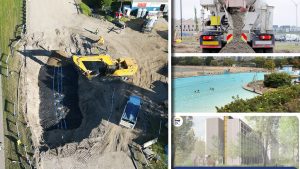Work could begin as early as this year on the second round of upgrades to the North Klondike Highway, a paved, two-lane road that connects Whitehorse to Dawson City in the Yukon Territory.
A 110-kilometre section of the all-season thoroughfare between Carmacks and Stewart Crossing is scheduled to be rebuilt and rehabilitated over a five-year construction period.
The governments of Canada and Yukon recently announced $180 million for the project. Two years ago, they earmarked $157 million over nine years for phase one of the project which entails upgrades to a separate 100-kilometre section of the road from north of Carmacks to just south of Dawson.
“The main driver of this project is to strengthen the highway’s resilience to climate change such as thawing permafrost,” says Paul Murchison, executive director of major programs for Yukon’s department of highways and public works.
“Thawing permafrost causes drainage and erosion issues which reduces safety for road users. These upgrades will reduce long-term maintenance costs and increase efficiency of travel by eliminating the need for weight restrictions for our heavy trucks transporting vital goods along the highway.”
The project is currently going through the environmental and regulatory process. It has not been tendered but Murchison says the project is moving along and he expects early work could begin in 2022. Up to 800 jobs may be created and supported over the construction period.
The highway is being rehabilitated because many sections are old and have broken down due to wear and tear, harsh winters, use by heavy mining trucks and thawing permafrost. Some sections of the road are missing foundations, so a key aspect of the work will be foundation strengthening.
With more rain and runoff, permafrost thaw, and significant frost heaves, work crews must repeatedly fix potholes and make repairs to the thoroughfare.
A better foundation will help drain water in spring when the snow melts and the ground begins to thaw. Shoulders of the highway will also be widened in many sections and the geometry of the road will be improved in areas where there are currently steep embankment slopes and grades.
Crews will also make drainage systems more efficient, raise the roadbed where possible so that it’s less affected by permafrost melt, and provide wider ditches to protect against flooding and slope erosion.
The work will vary depending on the location. Areas where there is flat terrain might require some widening and ditch work and foundational improvements while in other areas the road might have to be moved.
Murchison says some of the funding will be used to support the territory’s intelligent transportation system which includes a number of tools that help better manage the road and mitigate climate change. The tools include radar detection and weather monitoring which helps the province communicate road conditions to the travelling public through digital message signs.
Infrastructure for electric vehicle charging stations will also be developed between Carmacks and Stewart Crossing and the territory plans to install a new commercial vehicle weigh-in-motion system to allow heavy trucks to weigh their goods while driving.
“This will help create greater efficiency for transport of goods and provide automated permitting for those carrying heavy loads,” notes Murchison.
Production of geotechnical materials like aggregates and riprap will be ongoing during the first few years of the project to stockpile the necessary quantities for subsequent years of construction.
Murchison says work camps will be set up along the project route but the locations will be determined by the successful bidder.
The project will be divided into five components. Each will take two years of planning and two years of construction, and a final year to apply bituminous surface treatment, otherwise known as seal coat or chip seal which is a waterproof layer to protect the underlying pavement.
The project will fall under the territory’s new Yukon First Nations Procurement Policy which was developed through an innovative, collaborative process involving representatives of the territory and Yukon First Nations.
“This policy is intended to strengthen outcomes for Yukon First Nations people and businesses by providing opportunities for Yukon First Nations governments, businesses and people to participate in territorial procurements,” says Murchison.
“The new policy also encourages Yukon businesses to bid on government contracts in partnership with Yukon First Nations businesses. Ongoing engagement with First Nations is critical to this project’s success and contributing to building the relationship between Government of Yukon and Yukon First Nations.”
The highway is a key access route for more than 50 per cent of Yukoners who live outside of Whitehorse. It is one of the only all-season highways connecting the territory’s capital to remote, isolated communities and important resource development areas. The thoroughfare also provides the only road access to the Beaufort Delta region of the Northwest Territories.
Murchison says the project will make trade through the North Klondike Highway corridor easier to access by improving the efficiency of travel from natural resource development areas in Canada’s North.
The highway improvements will also eliminate weight restrictions for commercial and heavy trucks on the roadway that are used by the mining industry. The trucking industry presently has to deal with seasonal weight restrictions of 75 per cent in the spring.











Recent Comments
comments for this post are closed